#Outsource ruby on rails development
Explore tagged Tumblr posts
Text
Top Custom Software Development Companies in Europe [2025]
European companies are progressively adopting tailored software solutions to work more effectively. For organizations seeking a best-in-class custom software development partner, we present a selection of firms offering comprehensive, end-to-end services. It's vital to recognize the significant difference in the capability of various development providers to deliver genuinely effective custom software.
In order to facilitate the identification of your optimal partner, we have compiled a list of the most reputable custom software development companies in Europe, all of whom possess the capability to develop software solutions tailored to your specific business requisites.
VeryCreatives

VeryCreatives, a recognized leader in design and development, empowers businesses worldwide with exceptional software solutions. Our seasoned professionals excel at attracting more potential users and converting them effectively, leading to robust customer bases, improved retention, and substantial revenue streams for our partners.
Aionys

Aionys, a reputable custom software development company founded in Bulgaria in 2016, offers expert digital product development services to the financial services industry. Their strength lies in their experienced team of software developers, designers, project managers, and QA engineers, who are dedicated to delivering tailored and high-quality solutions.
instinctools

instinctools, with a history spanning over 10 years, specializes in the development of state-of-the-art software solutions designed to address unique business challenges. The company's distinctive methodological approach, coupled with the assembly of an exceptional cadre of technical talent at their Kraków headquarters in Central Europe, solidifies their position as a preeminent software firm in Poland.
Dotcode

For businesses and startups in the EU market, Dotcode, a custom software development company based in Ukraine with offices in the UK and US, specializes in building dedicated development teams. Their platform showcases their successful project history, and they offer IT outsourcing services to enhance existing products and develop scalable tech solutions globally.
Sigma Software
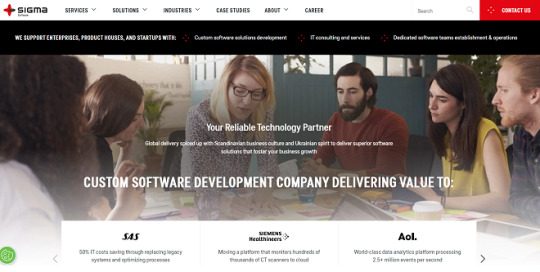
Sigma Software, founded in 2009, serves a wide international clientele, from the US to Australia, with a strong domestic and global presence. They specialize in tailored web and mobile application development and are recognized for their excellent client communication, high-quality code, and a reliable warranty period of 12 months or more.
DIGIWEDO

DIGIWEDO, a custom software development firm with a strong history, specializes in developing Minimum Viable Products (MVPs) and complete digital products for agile companies worldwide. They have expertise in Ruby on Rails for web applications and building feature-rich applications for both iOS and Android. DIGIWEDO has successfully delivered over 300 projects to clients in over 20 countries, managing the entire development lifecycle from the initial idea.
Strypes
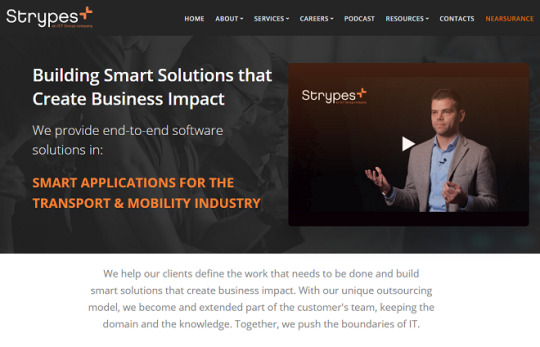
Strypes, a software house located in Eindhoven, Netherlands, provides both the establishment and management of dedicated development teams, configured to meet the bespoke requirements of its clientele, and the delivery of end-to-end projects across a range of core sectors, including IT infrastructure, Smart Applications, Remote Diagnostics and Monitoring software, Transport and Mobility, Cloud Solutions, and diverse business verticals.
CodeFirst
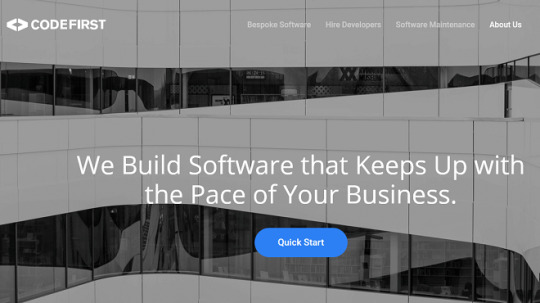
CodeFirst, a Custom Software Development Company, employs agile delivery methodologies and leverages its expertise in software development to ensure the provision of premium custom software solutions within the European market. The company is committed to delivering software products within or ahead of stipulated deadlines and at competitive pricing. Each project is regarded as an opportunity to apply the company's extensive experience, innovative solutions, and discerning intuition to consistently surpass client expectations.
#custom software development#software development#software developers#software development in Europe
0 notes
Text
Web Developers in Sydney
Web Developers in Sydney

The Importance of Web Developers in Sydney
Sydney is one of Australia's most technologically advanced cities, home to a bustling startup ecosystem, corporate giants, and creative agencies. As businesses compete for consumer attention, the need for skilled web developers has surged.
Web developers in Sydney don't just build websites—they craft digital experiences that align with brand goals and user expectations. They use a mix of technical expertise, creative flair, and market knowledge to design responsive, user-friendly, and performance-optimized websites. These websites not only look good but also perform well in terms of speed, usability, SEO, and conversions.
Whether it’s an e-commerce platform, a service-based website, or a custom web application, developers ensure that every aspect is tailored to meet business objectives and user needs.
Services Offered by Web Developers in Sydney
Web development is a broad field that includes a wide array of services. Most web development agencies or freelance professionals in Sydney offer the following:
Custom Website Development
Many Sydney businesses prefer custom-built websites over templated designs to stand out from the crowd. Custom websites are created from scratch with unique code, design, and functionality. This ensures a high degree of flexibility, scalability, and brand alignment.
E-commerce Development

Content Management Systems (CMS)
Platforms like WordPress, Joomla, and Drupal are popular among businesses that need to frequently update their website content. Web developers configure and customize CMS platforms, allowing clients to manage content with ease.
UI/UX Design
User interface (UI) and user experience (UX) are critical for website success. Sydney web developers often collaborate with UI/UX designers to create seamless, intuitive interfaces that keep users engaged and encourage conversions.
Mobile-Responsive Design
With over 60% of web traffic coming from mobile devices, responsive design is non-negotiable. Sydney developers ensure that websites look and function flawlessly across all screen sizes and devices.
Web Application Development
Beyond simple websites, many developers in Sydney specialize in building complex web applications—think booking systems, customer portals, and SaaS platforms—tailored to specific business needs.
SEO and Performance Optimization
A website’s success depends on visibility and speed. Web developers integrate SEO best practices and optimize site performance to ensure high search rankings and fast loading times.
Website Maintenance and Support
Once a website goes live, it needs regular updates, bug fixes, and enhancements. Many Sydney-based developers offer ongoing support to ensure optimal performance and security.
Popular Technologies Used by Sydney Web Developers

Front-End: HTML5, CSS3, JavaScript, React.js, Vue.js, Angular
Back-End: PHP, Python, Ruby on Rails, Node.js
Databases: MySQL, PostgreSQL, MongoDB
CMS Platforms: WordPress, Joomla, Drupal
E-commerce: Shopify, WooCommerce, Magento, BigCommerce
Web Hosting: AWS, DigitalOcean, SiteGround, Bluehost
The choice of technology often depends on the project scope, budget, and client preferences.
Benefits of Hiring Local Web Developers in Sydney
While outsourcing development work overseas can be cost-effective, hiring local web developers in Sydney comes with a unique set of advantages:
Better Communication and Collaboration
Time zone alignment, face-to-face meetings, and real-time communication make collaboration smoother and more efficient. Working with a local developer eliminates language barriers and ensures everyone is on the same page.
Understanding of Local Market Trends
Sydney-based developers are well-acquainted with the Australian market, consumer behavior, and regulatory requirements. This local insight is invaluable when building websites tailored for the region.
Quality Assurance
Local developers often adhere to Australian standards for accessibility, data protection, and performance. They also provide hands-on support and quicker turnaround for urgent issues.
Ongoing Support and Maintenance
Having a local point of contact for ongoing updates and troubleshooting is a major benefit. Whether it's a bug fix or a design tweak, local developers are more accessible.
How to Choose the Right Web Developers in Sydney
The success of your digital project hinges on choosing the right development team. Here’s a step-by-step guide to help you make an informed decision:
Define Your Goals
Before you approach any developer, be clear about your project goals. Are you building a brand-new site, revamping an old one, or creating an application? What are the must-have features?
Check Their Portfolio
Review the developer’s past projects to assess their design aesthetic, technical ability, and industry experience. A good portfolio is often a reliable indicator of what they can deliver.
Read Client Reviews
Check testimonials and third-party reviews on platforms like Clutch, Google, and Upwork. Look for patterns in client feedback—especially around communication, deadlines, and post-launch support.
Ask About Their Process
A reliable developer will follow a structured process that includes discovery, design, development, testing, and deployment. Ask for transparency on timelines, project milestones, and deliverables.
Discuss Budget and Timelines
Get a detailed quote and timeline upfront. Ensure there are no hidden fees and that all costs, including revisions and support, are clearly outlined.
Look for Ongoing Support
A good web development partner offers more than just a finished product—they offer long-term support to ensure your site evolves with your business.
The Future of Web Development in Sydney
The web development landscape in Sydney is constantly evolving. As new technologies emerge—like Progressive Web Apps (PWAs), artificial intelligence, and headless CMS—Sydney developers are quick to adapt. Many are also integrating accessibility standards (WCAG), sustainability principles (green hosting), and inclusive design practices into their workflows.
With Sydney’s growing reputation as a digital innovation hub, the demand for skilled web developers is expected to rise. This growth will be fueled by emerging industries, government investments in tech infrastructure, and the ongoing digital transformation of traditional businesses.
Final Thoughts
Web developers in Sydney are essential partners for businesses aiming to build a powerful online presence. From custom websites to scalable web applications, they bring a mix of technical skill and local market knowledge that delivers real results. Whether you're launching a new venture or upgrading your current digital platform, partnering with the right web developer in Sydney can make all the difference.
By doing your research, setting clear goals, and choosing a developer that aligns with your vision, you’ll be well on your way to building a standout website that drives growth, engagement, and success.
0 notes
Text
Choosing the Right Back-End Development Services for Your Business Needs
Imagine you’ve built a stunning storefront for your business—visually appealing, easy to navigate, and inviting. But what if the doors don’t open properly, the inventory doesn’t update, and the checkout process is painfully slow? That’s exactly what happens when a business lacks a strong back-end foundation.

Back-end development is the backbone of any digital platform, ensuring seamless operations, data management, and security. Whether you’re a startup or an established business, choosing the right back-end development services can make or break your success. In this guide, we’ll walk you through everything you need to consider before making this critical decision.
Understanding Back-End Development Services
Back-end development refers to the server-side technologies that power a website or application. Unlike front-end development, which focuses on user experience, back-end development is responsible for database management, application logic, server communication, and overall performance.
Key Components of Back-End Development:
Database Management – Storing and retrieving data efficiently
Server-Side Programming – Processing user requests and delivering responses
Security & Authentication – Protecting user data from breaches
API Development – Connecting different services and applications
Performance Optimization – Ensuring smooth and fast operations
Factors to Consider When Choosing Back-End Development Services
1. Your Business Goals & Requirements
Before selecting a back-end development service, clearly define your business needs:
Are you developing an eCommerce website, SaaS product, or a mobile app?
Do you need real-time data processing?
Will your platform require high security, such as banking or healthcare applications?
Understanding these factors helps you determine the right technology stack and service provider.
2. Technology Stack & Frameworks
Different back-end technologies cater to different business requirements. Here are some popular choices:
Node.js – Ideal for real-time applications and scalable solutions
Python (Django, Flask) – Great for AI-based applications and data-driven platforms
Ruby on Rails – Best for quick development and MVPs
Java (Spring Boot) – Reliable for enterprise-level applications
PHP (Laravel, Symfony) – Suitable for web development and CMS platforms
Choose a back-end development service that specializes in your preferred technology stack.
3. Scalability & Performance
Your business will grow, and your back-end infrastructure should support that growth. Ask yourself:
Can the system handle an increase in traffic?
Is the back-end optimized for speed and performance?
Does it support cloud integration for easy scalability?
Opt for services that provide scalable solutions and performance-driven architecture.
4. Security & Data Protection
Security breaches can be devastating. Ensure that your chosen back-end service offers:
Data encryption and secure authentication
Compliance with industry standards (GDPR, HIPAA, PCI-DSS)
Regular security audits and threat monitoring
A robust security framework will protect your business and customers from potential cyber threats.
5. Integration & API Support
A good back-end service should seamlessly integrate with third-party applications and services. This includes:
Payment gateways (PayPal, Stripe)
CRM systems (Salesforce, HubSpot)
Analytics tools (Google Analytics, Mixpanel)
APIs (Application Programming Interfaces) ensure smooth communication between different platforms and services.
6. Development Team Expertise & Support
When outsourcing back-end development, consider the team’s:
Experience & Portfolio – Review past projects and case studies
Communication & Collaboration – Ensure transparent updates and feedback
Support & Maintenance – Look for long-term support for bug fixes and updates
A reliable back-end development team will save you time, money, and headaches in the long run.
Custom vs. Pre-Built Back-End Solutions
When selecting a back-end solution, you have two main options:
1. Custom Development
Pros:
Tailored to specific business needs
Offers better scalability and flexibility
Higher security and control
Cons:
Longer development time
Higher initial cost
2. Pre-Built Solutions (BaaS - Backend-as-a-Service)
Pros:
Faster deployment
Lower upfront costs
Includes built-in security features
Cons:
Limited customization
May not support all business requirements
If your business needs a unique and scalable infrastructure, custom development is the way to go. However, if you need a quick and cost-effective solution, a BaaS platform like Firebase or AWS Amplify might be a better fit.
Final Thoughts
Choosing the right back-end development services is a crucial decision that can impact your business’s growth, security, and performance. By evaluating your business needs, selecting the right technology stack, and prioritizing security and scalability, you can ensure a strong foundation for your digital platform.
Whether you go for a custom-built solution or a pre-packaged backend service, always partner with experienced professionals who understand your vision. After all, a solid back-end is what keeps your business running smoothly behind the scenes.
0 notes
Text
Python vs. Other Languages Why It's the Top Choice for Beginners

Introduction
If it's your first time learning to program, you may find that some aspects of this process can be outsourced. With so many choices, it can be hard to decide which is the best. Python vs other languages — here's why it's the top choice for beginners. Python's simplicity, readability, and a myriad of applications make it a perfect launching block for every budding programmer.
What Extra Distinction Does Python Enjoy?
Simple Syntax and Readability
Python syntax is especially beginner-friendly. It was created to be easily understood by new learners. Compared to other languages with abnormal amounts of complexity in terms of syntax, Python really looks like plain English.
Versatility With Applications Base in Domain
From web development to artificial intelligence, Python goes where you go. Building websites? Running data analysis? Script-building automation? Python's got it all.
Constant Global Community Support
This grant in great measure gives Python its days and years of survival. Wealth of tutorials, documentation, and online forums pour in to support beginner users.
So How Do Python and Other Popular Languages Compare?
Python vs. Java
Syntax: Far simpler than java. This translates to fewer lines of code in Python.
Performance: Java is faster, but Python is flexible.
Use Cases: Java is common in large enterprise applications, while Python is preferred for data science and automation.
Python vs. C++
Learning Curve: Thanks to its complex syntax and memory management, C++ has a steep learning curve.
Memory Management: Python does it automatically; C++ needs it to be done by the programmer.
Best For: C++ is great for system programming and game development, whereas Python is great for automation and AI.
Python vs. JavaScript
JavaScript is mostly limited in application to web development; Python has several applications.
Python is simpler and thus a better first step.
Both are in high demand; however, Python is gaining increased traction in AI and data science.
Python vs. C#
Both are object-oriented.
C# programming is usually employed in game development, while Python reigns in AI and automation.
Python is the best for the beginner due to its easy syntax.
Python vs. Ruby
Web Development: Ruby is known for Rails, while Python has Django.
Community Support: Both have strong communities, but Python has more extensive resources.
Learning Curve: Python is generally easier to learn.
Key Reasons Python is Best for Beginners
Readability and Simplicity
Python’s clear syntax makes learning programming less intimidating.
Extensive Libraries and Frameworks
Python offers countless libraries that simplify development, from NumPy for data science to Flask for web development.
Large and Supportive Community
Beginners can easily find tutorials, online courses, and documentation to help them learn Python quickly.
Strong Industry Demand
Python skills are in high demand across industries, including AI, data science, and finance.
Common Use Cases of Python
Web Programming: Frameworks include Django or Flask.
Data Science: Pandas and NumPy perform data analysis.
AI, ML: TensorFlow gets used in AI programming, and Scikit-learn means ML programming.
Automation: It works for writing scripts to automate repetitive jobs.
Game Development: Pygame for interactive game design.
Conclusion
The simple programming environments give Python great beginner appeal. It is also widely used in various fields such as web development, data crunching, or AI-based applications. Therefore, choosing Python is the right start for you!
Location: Bopal & Iskon-Ambli Ahmedabad, Gujarat
Call now on +91 9825618292
Visit Our Website: http://tccicomputercoaching.com/
FAQs
Is Python faster than Java?
Java is generally faster, while Python is more flexible and easier to use.
Can I use Python for web development?
Yes, it makes web development easy with frameworks such as Django and Flask.
How long does it take to learn Python?
It can take a couple of weeks to learn basic Python with regular practice.
Which industries use Python the most?
AI, data science, web development, and automations-mandates Python use.
Do I need prior programming experience to learn Python?
No, absolutely not-Python is easy to get started with, even for a complete novice.
#Best Computer Classes in Ahmedabad#Comparing Python to Other Languages#Python difference from other languages#Python vs Other Languages#TCCI-Tririd Computer Coaching Institute
0 notes
Text
Unlock Business Growth With Expert Software Development Services

In today's digital era, businesses need robust and scalable software solutions to stay ahead of the competition. Whether it's developing a custom mobile application or a full-fledged enterprise platform, companies seek reliable partners who can deliver high-quality solutions efficiently. One of the best strategies to achieve this is to Outsource Software Development India, where businesses can leverage cost-effective, high-quality development services with a skilled talent pool.
Why Outsource Software Development in India?
Choosing to Outsource Software Development India offers multiple advantages, including access to top-notch developers, cost efficiency and faster project execution. Indian software development firms provide tailored solutions across various industries, ensuring that businesses get cutting-edge applications while maintaining flexibility in their development processes.
Key Benefits:
Highly skilled and experienced software engineers
Cost-effective development without compromising on quality
Agile methodologies for faster product delivery
24/7 support and maintenance services
Seamless integration of the latest technologies
Outsourcing software development allows companies to focus on their core business while ensuring that their technology needs are handled by experts.
The Role of a Full Stack Development Company in India
A Full Stack Development Company India offers end-to-end solutions for businesses looking for web and mobile applications. These companies specialize in both front-end and back-end technologies, ensuring a seamless user experience with robust backend infrastructure.
Advantages of Hiring a Full Stack Development Company:
Expertise in front-end technologies like React, Angular and Vue.js
Proficiency in back-end frameworks such as Node.js, Python and Ruby on Rails
Comprehensive database management solutions
API development and third-party service integration
Scalable and secure software architecture
By partnering with a Full Stack Development Company India, businesses can accelerate their digital transformation with custom-built, high-performance applications tailored to their needs.
The Growing Demand for Mobile App Development in India
With the rise in smartphone usage, businesses across industries are investing in mobile applications to enhance customer engagement and streamline operations. A Mobile App Development Company India specializes in creating user-friendly, feature-rich applications for iOS and Android platforms.
Benefits of Hiring a Mobile App Development Company:
Custom mobile applications tailored to business needs
Cross-platform development for wider reach
Integration of advanced technologies like AI, AR/VR and IoT
Secure and scalable mobile solutions
Continuous support and updates for seamless performance
A Mobile App Development Company India ensures that businesses stay ahead in the digital space by offering innovative and high-performing mobile applications that cater to their target audience.
Why Choose BuzzyBrains for Your Software Development Needs?
When it comes to software development, BuzzyBrains is a trusted name in the industry. Specializing in full-stack development, mobile app solutions and software outsourcing, BuzzyBrains delivers innovative technology solutions that drive business growth.
Why BuzzyBrains?
A team of highly skilled developers with expertise in the latest technologies
Agile methodologies for quick and efficient project execution
Cost-effective solutions without compromising on quality
End-to-end development services, from planning to deployment
Excellent client support and long-term partnership approach
Conclusion
In a rapidly evolving digital landscape, businesses need expert technology partners to stay competitive. Choosing to Outsource Software Development India provides companies with cost-effective, high-quality solutions. Collaborating with a Full Stack Development Company India ensures comprehensive software solutions, while a Mobile App Development Company India helps businesses expand their reach in the mobile ecosystem. With BuzzyBrains, businesses gain access to world-class development services that accelerate growth and innovation.
#buzzybrains software#custom software development company in india#mobile app development companies in india#mobile app development company india#software development company india#custom software development in india#outsource software development company in india
0 notes
Text
Outsource & Ruby Web Dev Experts

When it comes to building scalable, dynamic web applications, businesses often turn to Ruby for its simplicity and power. Coupling this with outsourcing creates a strategy that brings together cost savings and access to top-tier talent globally. Let's delve into how outsourcing and Ruby web development combine to create magic.
What is Outsourcing in Web Development?
Outsourcing has revolutionized the way companies approach software development. It allows businesses to hire external professionals to handle their web development needs, often at a fraction of the cost. Outsource & Ruby Web Dev Experts
Definition and Overview
Outsourcing involves delegating your project to skilled developers or agencies outside your organization. This can range from hiring freelancers for small tasks to engaging large agencies for end-to-end solutions. The approach saves resources, reduces workload, and ensures access to diverse expertise.
Key Benefits of Outsourcing
Cost Savings: Outsourcing significantly reduces labor and operational costs.
Access to Talent: You gain access to a global pool of experienced developers.
Focus on Core Business: While experts handle web development, you can concentrate on your business goals.
Flexibility: Scale your team up or down based on project requirements.
Why Choose Ruby for Web Development?
Ruby, known for its elegance and productivity, powers many successful web applications. Its flagship framework, Ruby on Rails (RoR), is particularly famous for rapid application development and scalability.
Understanding Ruby and Its Frameworks
Ruby is a high-level programming language designed to make coding simple and efficient. Ruby on Rails amplifies this by providing a framework that speeds up development without compromising quality. Features like MVC architecture, database migrations, and reusable code make it a developer favorite.
Advantages of Using Ruby for Web Development
Efficiency: Ruby simplifies complex coding tasks, allowing developers to build robust apps quickly.
Scalability: It’s perfect for startups and enterprises looking to scale.
Rich Libraries: Ruby Gems offer pre-built solutions for almost every functionality.
Community Support: A strong community ensures continuous improvement and readily available resources.
The Benefits of Outsourcing Ruby Web Development
Access to Global Talent
Outsourcing connects you to a world of Ruby web developers, each bringing unique skills and expertise.
High-Quality Developers Worldwide
Whether you need a senior Ruby developer or an entire team, outsourcing platforms offer vetted professionals ready to dive into your project. These developers come from diverse backgrounds, ensuring innovative approaches.
Diverse Skill Sets Across Time Zones
Outsourcing opens the door to specialists in various aspects of Ruby, from backend development to API integrations. The added benefit? Teams across time zones can work around the clock, speeding up your project.
Cost Efficiency
One of the main drivers behind outsourcing is the cost advantage. Ruby web development, while premium, becomes more affordable with outsourcing.
Lower Development Costs Compared to In-House Teams
Hiring an in-house team can be expensive due to salaries, benefits, and training costs. Outsourcing eliminates these overheads, making it a budget-friendly alternative.
Budget Flexibility and Scalability
Outsourcing allows you to choose developers based on your budget. Whether you need a small feature or a complex application, there’s a solution for every budget.
Faster Time-to-Market
Speed is often critical in web development. Outsourcing Ruby experts ensures faster project delivery without sacrificing quality.
Leveraging Experienced Ruby Developers
Seasoned developers with years of experience can jumpstart your project, avoiding the trial-and-error phase often seen with less experienced teams.
Streamlined Development Processes
Outsourced teams typically follow structured processes, ensuring timelines are met. Agile methodologies and clear milestones keep the project on track.
How to Choose the Right Ruby Web Dev Experts
Finding the right Ruby web development experts is crucial for project success. From technical proficiency to communication skills, several factors influence the selection process. Let’s explore the best practices to identify top talent.
Evaluate Technical Expertise
Technical prowess is the foundation of any successful development project. When outsourcing Ruby experts, their coding knowledge and experience with frameworks like Ruby on Rails are paramount.
Proficiency in Ruby and Ruby on Rails
Ruby is a versatile language, but its power is amplified by frameworks like Ruby on Rails. A developer’s expertise in these tools ensures they can handle everything from building complex architectures to debugging effectively. Look for professionals who demonstrate:
Mastery of Ruby syntax and conventions.
Experience with Rails libraries and modules.
Understanding of key concepts like MVC (Model-View-Controller).
Understanding API Integration and Security
Modern web applications rely heavily on integrations. Developers should have experience with APIs, RESTful services, and third-party integrations. Moreover, security is non-negotiable, especially in an era of rising cyber threats. Ruby developers should:
Implement secure coding practices.
Understand data encryption techniques.
Use Rails features like strong parameters to protect applications.
Assess Communication and Collaboration Skills
Even the most skilled developers need to communicate effectively, especially in remote setups. Miscommunication can lead to delays, missed expectations, and a lack of trust.
Importance of Clear Communication
Choose developers or teams who can articulate ideas and provide regular updates. Look for:
Responsiveness in communication.
Fluency in your preferred language.
Transparency about challenges and progress.
Tools to Enhance Remote Collaboration
Effective collaboration tools are vital for outsourced teams. Ruby experts should be familiar with:
Project management platforms like Jira or Trello.
Communication tools like Slack or Zoom.
Code repositories like GitHub or Bitbucket.
Look for Proven Experience
Experience matters when choosing Ruby web dev experts. Seasoned developers can anticipate challenges and offer solutions that inexperienced professionals might miss.
Check Portfolio and Case Studies
Reviewing previous projects gives insight into a developer’s expertise. Look for:
A variety of projects showcasing versatility.
Case studies highlighting problem-solving skills.
Examples of scalable and high-performance applications.
Seek Testimonials and References
Client feedback speaks volumes. Testimonials and references provide a glimpse into a developer’s work ethic, reliability, and technical skills. Don’t hesitate to:
Ask for direct client references.
Verify claims by contacting past employers or clients.
Best Practices for Outsourcing Ruby Web Development
Outsourcing is only as effective as your management of the process. Following these best practices ensures a seamless experience and high-quality output.
Define Your Project Scope Clearly
A well-defined project scope is the cornerstone of successful outsourcing. Clear documentation reduces ambiguity and sets the stage for smooth execution.
Creating a Detailed Requirement Document
Include every detail, from functionality requirements to design preferences. Your document should cover:
Core features and functionality.
Non-functional requirements like performance and scalability.
User interface and experience expectations.
Setting Clear Timelines and Milestones
Break your project into smaller phases with specific deliverables. This ensures developers can focus on one aspect at a time and makes progress easier to track.
Use the Right Project Management Tools
Project management tools are essential for tracking progress, assigning tasks, and ensuring accountability.
Popular Tools for Effective Management
Trello: Simple and visual task management.
Asana: Comprehensive project tracking.
Jira: Best for agile teams and detailed workflows.
Benefits of Real-Time Tracking
Real-time tracking provides visibility into the project’s status. This transparency:
Reduces misunderstandings.
Helps identify bottlenecks early.
Keeps stakeholders informed.
Establish Transparent Contracts
Contracts ensure everyone is on the same page regarding deliverables, payment, and expectations.
Importance of Legal Agreements
Draft contracts that outline:
Project scope and milestones.
Payment terms and schedules.
Confidentiality and non-disclosure clauses.
Setting Expectations on Deliverables
Include specific expectations for quality, timelines, and testing. This clarity minimizes disputes and ensures smooth collaboration.
Challenges and Solutions in Outsourcing Ruby Web Development
Outsourcing isn’t without challenges. However, proactive planning and strategic solutions can help overcome them effectively.
Common Challenges
Understanding potential obstacles is the first step in addressing them.
Communication Gaps
Language barriers and unclear instructions can lead to misunderstandings. Regular updates and visual aids like mockups can bridge these gaps.
Cultural and Time Zone Differences
Cultural differences may influence work styles, while time zones can delay communication. Align expectations early and use overlapping hours for critical meetings.
Effective Solutions
These challenges can be mitigated with proper strategies.
Regular Meetings and Updates
Frequent check-ins ensure all stakeholders are aligned. Schedule:
Weekly progress meetings.
Daily stand-ups for agile projects.
Using Collaboration Platforms
Platforms like Slack or Zoom can streamline communication, while tools like Miro offer visual collaboration capabilities.
Outsourcing Ruby web development is a powerful strategy that combines the technical excellence of Ruby with the efficiency of global talent. By choosing the right experts and following best practices, businesses can achieve scalable, high-performance applications without overstretching their budgets.
From understanding Ruby’s advantages to tackling outsourcing challenges, you now have a roadmap to make informed decisions. As technology evolves, Ruby remains a reliable choice for modern web applications, and outsourcing ensures you leverage the best talent while focusing on your core objectives.
Visit Here: https://www.codetalenthub.io/
1 note
·
View note
Text
Robust Laravel Application Development - Lessons Learned
Introduction
Building a robust Laravel application that can scale, handle high traffic, and remain maintainable over time is not without its challenges. Over the years, developers and teams have encountered several common pitfalls and learned invaluable lessons while building and maintaining large-scale Laravel applications.

Developing robust applications with Laravel requires careful planning, attention to detail, and adherence to best practices. It is also essential to have an in-depth understanding of the intricacies of secure and scalable architecture. This would ideally mean trusting a software development outsourcing company like Acquaint Softtech.
This article provides more information on the lessons learned from building robust Laravel applications. It focuses on best practices, common mistakes, and solutions to improve application scalability, security, maintainability, and performance.
Laravel Application Development

Laravel has rapidly become one of the most popular PHP frameworks due to its expressive syntax, rich ecosystem, and developer-friendly features. With Laravel, developers can build modern web applications with ease, thanks to the abundance of built-in tools, comprehensive documentation, and support for modern PHP standards.
It is a powerful PHP framework that offers developers a structured and efficient way to build web applications. There are many reasons why Laravel is the ideal web framework. It has an elegant syntax, follows the MVC architecture, and has a special Blade templating engine.
Besides this, Laravel also eliminates the need to build an authentication system from scratch since it is in-built. The special object-relational mapping, Eloquent CRM helps simplify the database operations.
But that's not all. Not only does Laravel have good features to build a robust solution, but it also has the necessary tools and features to help you test it. Testing, debugging, and validation are highly simplified with Lararel. It allows the use of special test tools like PHPUnit and PEST.
Here are a few interesting statistics:
2706 of the Laravel powered websites are from the Web Development sector. (6sense)
Over 303,718 Americans use Laravel, while this figure is 54,648 in the United Kingdom and 31,053 in Russia. (BuiltWith)
As data collected in 2024, 7.9% of developers use the Laravel framework worldwide while 4.7% use Ruby on Rails, 3.2% use Symfony framework and 1.7% use Codeigniter.
Node.js is one of the most popular with 40.8% using it; React comes close second at 39.5%
Lessons Learned

Understand the MVC Architecture Thoroughly : Lesson 1
Laravel adheres to the Model-View-Controller (MVC) architecture, which separates the application logic from the user interface. This separation is critical for building scalable and maintainable applications. One of the key lessons learned from working with Laravel is that a deep understanding of the MVC architecture is essential for building a robust application.
Model: Represents the data layer and handles business logic.
View: The user interface that the end-user interacts with.
Controller: Mediates between the Model and the View, processing user requests and sending the appropriate response.
A common mistake is allowing business logic to seep into the controller or view. This breaks the MVC pattern, making the application harder to maintain and test. Adhering to strict separation of concerns ensures that each application part can be developed, tested, and maintained independently.
Key Takeaway: Always ensure that business logic resides in models or services, controllers handle user requests, and views strictly present data without containing any application logic.
Use Eloquent ORM Effectively : Lesson 2
Laravel's built-in Object Relational Mapping (ORM) tool (Eloquent) provides a simple and elegant way to interact with the database. However, improper use of Eloquent can lead to performance issues, especially in large applications with complex database queries.
Common Mistakes: N+1 Query Problem: The N+1 problem occurs when a query retrieves a list of items but then executes additional queries to fetch related items for each entry. This can lead to hundreds of unnecessary database queries. To avoid this, Laravel offers the with() method for eager loading relationships.
php code
// Bad
$posts = Post::all();
foreach ($posts as $post) {
echo $post->author->name;
}
// Good (Using eager loading)
$posts = Post::with('author')->get();
foreach ($posts as $post) {
echo $post->author->name;
}
Mass Assignment Vulnerabilities: Laravel's MassAssignment allows you to bulk insert or update data in the database. However, safeguarding against mass assignment can expose your application to vulnerabilities. Developers should always use $fillable or $guarded properties in their models to protect against mass assignment.
php code
// Protecting against mass assignment
protected $fillable = ['title', 'content', 'author_id'];
Solutions: Always use eager loading to avoid the N+1 problem.
Define fillable attributes to protect against mass assignment.
Avoid complex queries in models. Instead, use Query Builder for more advanced database interactions that Eloquent struggles with.
Key Takeaway: Use Eloquent for simple CRUD operations, but be mindful of performance concerns and security risks. When necessary, fall back on Laravel’s Query Builder for complex queries.
Service Layer for Business Logic : Lesson 3
As Laravel applications grow, keeping controllers slim and models focused on data becomes increasingly important. This is where the service layer comes in. Service classes allow developers to isolate business logic from controllers and models, making the application more modular and easier to test.
Example:
Instead of handling user registration logic in the controller, a service class can be created to handle it.
PHP code
// In the UserController
public function store(UserRequest $request)
{
$this->userService->registerUser($request->all());
}
// In UserService
public function registerUser(array $data)
{
$user = User::create($data);
// Other business logic related to registration
}
This pattern makes it easier to maintain, test, and scale the application as business logic becomes more complex.
Key Takeaway: Introduce a service layer early on for business logic to improve code organization and maintainability.
Prioritize Security at Every Step : Lesson 4
Security is a fundamental aspect of building a robust Laravel application. One of the lessons learned from years of Laravel development is that security should not be an afterthought. Laravel provides many built-in security features, but it’s up to developers to use them correctly.
Key Security Practices:
Sanitize Input: Always sanitize user inputs to prevent XSS (Cross-Site Scripting) and SQL injection attacks. Laravel automatically escapes output in Blade templates, which helps protect against XSS. For SQL injection protection, always use Eloquent or Query Builder.
Use CSRF Protection: Laravel automatically protects against Cross-Site Request Forgery (CSRF) by including a CSRF token in forms. Developers must ensure that CSRF protection is not disabled unintentionally.
Authentication and Authorization: Laravel offers built-in authentication and authorization mechanisms through policies, gates, and middleware. Use them to control access to resources and ensure users have the necessary permissions.
Password Hashing: Always store user passwords using Laravel’s Hash facade, which uses bcrypt by default. Avoid storing plain-text passwords in the database.
PHP
$user->password = Hash::make($request->password);
Rate Limiting: To prevent brute force attacks, implement rate limiting using Laravel’s RateLimiter facade.
Secure API Development: When building APIs, use OAuth2 or Laravel Sanctum for token-based authentication. Also, rate limiting for API endpoints should be implemented to prevent abuse.
Key Takeaway: Leverage Laravel's built-in security features and be proactive in identifying potential vulnerabilities.
Lesson 5: Cache Strategically for Performance
Caching is critical for improving the performance of Laravel applications, especially as they scale. Laravel supports various caching mechanisms, including file, database, Redis, and Memcached.
Best Practices for Caching:
Cache Expensive Queries: If your application frequently runs heavy queries, consider caching the results to reduce the load on the database.
PHP code
$users = Cache::remember('users', 60, function () {
return User::all();
});
Route Caching: Laravel provides a route:cache Artisan command to cache all routes in your application. This can significantly improve the performance of larger applications.
Bash CODE
php artisan route:cache
View Caching: Similarly, views can be cached to avoid unnecessary recompilation.
Bash CODE
php artisan view:cache
Optimize Configuration Loading: Use config:cache to combine all configuration files into a single file, reducing the time it takes to load configurations during requests.
bash CODE
php artisan config:cache
Key Takeaway: Use caching strategically to optimize performance and reduce server load, especially for database-heavy applications.
Optimize Database Interactions : Lesson 6
Efficient database interaction is critical for building scalable Laravel applications. Poorly optimized queries or over-reliance on ORM abstractions can lead to performance bottlenecks.
Best Practices for Database Optimization:
Database Indexing: Ensure that frequently queried columns are indexed. Laravel’s migration system supports creating indexes with ease.
php code
Schema::table('users', function (Blueprint $table) {
$table->index('email');
});
Avoid SELECT * Queries: Always specify the columns you need in a query. Fetching all columns unnecessarily increases the load on the database and memory usage.
php code
$users = User::select('id', 'name', 'email')->get();
Use Pagination: For large datasets, always paginate results rather than fetching everything at once.
php code
$users = User::paginate(15);
Database Query Profiling: Use Laravel’s built-in query log to identify slow queries. You can enable query logging with the following code:
php code
DB::enableQueryLog();
Key Takeaway: Optimize database queries by using indexes, avoiding unnecessary data fetching, and employing efficient pagination techniques.
Test Your Application : Lesson 7
Testing is a crucial aspect of robust Laravel application development. Laravel comes with PHPUnit integration, making it easy to write unit tests, feature tests, and browser tests. However, many developers tend to skip or neglect testing due to time constraints, which often leads to bugs and regressions.
Testing Best Practices:
Unit Tests: Unit tests focus on testing individual components or methods. They are fast and reliable but don’t cover the whole application flow.
php code
public function testUserCreation()
{
$user = User::factory()->create();
$this->assertDatabaseHas('users', ['email' => $user->email]);
}
Feature Tests: Feature tests allow you to test the entire application flow, from requests to responses. They ensure that the application behaves as expected in real-world scenarios.
php code
public function testUserRegistration()
{
$response = $this->post('/register', [
'name' => 'John Doe',
'email' => '[email protected]',
'password' => 'secret',
'password_confirmation' => 'secret',
]);
$response->assertStatus(302);
$this->assertDatabaseHas('users', ['email' => '[email protected]']);
}
Continuous Integration: Integrate automated tests with a continuous integration (CI) tool such as GitHub Actions or Travis CI. This ensures that your tests are automatically run whenever new code is pushed, preventing broken code from being deployed.
Key Takeaway: Always write tests for critical application components and workflows to ensure stability and reliability.
Prioritize Code Maintainability and Readability : Lesson 8
Laravel is known for its elegant syntax and developer-friendly structure, but as the application grows, maintaining clean and readable code becomes challenging.
Best Practices for Maintainability:
Follow PSR Standards: Laravel encourages following the PHP-FIG’s PSR standards, such as PSR-2 for coding style and PSR-4 for autoloading. Following these standards ensures that your codebase remains consistent and easy to navigate.
Use Named Routes: Using named routes instead of hard-coded URLs makes it easier to manage changes in the URL structure.
php code
Route::get('/user/profile', 'UserProfileController@show')->name('profile');
Refactor Regularly: As the application evolves, refactor code regularly to avoid technical debt. Use Laravel’s php artisan make:command to create custom Artisan commands that automate repetitive tasks.
Comment and Document: Clear comments and documentation help other developers (or even yourself in the future) understand the purpose of the code. Use Laravel’s DocBlocks to document classes, methods, and variables.
Key Takeaway: Invest in code quality by following coding standards, refactoring regularly, and documenting thoroughly.
Leverage Laravel’s Ecosystem : Lesson 9
Laravel has an extensive ecosystem that can simplify development and add powerful features to your application. Leveraging this ecosystem can save Laravel application development time and reduce complexity.
Key Laravel Tools and Packages:
Laravel Horizon: Provides a dashboard and tools to monitor queues and jobs in real-time.
Laravel Echo: Integrates WebSockets and real-time broadcasting capabilities into Laravel applications.
Laravel Telescope: A debugging assistant that allows you to monitor requests, queries, exceptions, logs, and more.
Laravel Sanctum: API authentication using tokens is especially useful for single-page applications (SPAs).
Laravel Vapor: A serverless deployment platform for Laravel that enables you to deploy Laravel applications on AWS Lambda without managing infrastructure.
Key Takeaway: Use Laravel’s ecosystem of tools and packages to extend your application’s capabilities and streamline development.
Prepare for Scalability : Lesson 10
As your Laravel application grows, you need to ensure that it can scale to handle increased traffic and data.
Key Scalability Considerations:
Horizontally Scale Your Database: As your user base grows, consider using database replication to scale horizontally. Laravel supports multiple database connections and read-write splitting.
Use Job Queues: Offload time-consuming tasks (such as sending emails or processing files) to queues. Laravel’s queue system supports drivers like Redis, Beanstalkd, and Amazon SQS.
Optimize Load Balancing: For high-traffic applications, consider using a load balancer to distribute incoming traffic across multiple application servers.
Containerization: Use Docker to containerize your Laravel application. Containerization ensures that your application can run consistently across various environments and can be scaled easily using orchestration tools like Kubernetes.
Key Takeaway: Plan for scalability from the start by using job queues, load balancing, and database replication.
Use Configuration and Environment Management Properly : Lesson 11
Lesson: Mismanaged environment configurations can lead to security and stability issues.
Practice: Store sensitive configurations like database credentials, API keys, and service configurations in .env files. Utilize Laravel’s configuration caching (config:cache) for production environments.
Tip: Regularly audit .env files and restrict sensitive data from being logged or committed to version control.
Some of the other lessons learned from developing a robust Laravel solution include that it has Artisan. This allows one to use a command line tool, Artisan, that can automate repetitive tasks. This serves the purpose of accelerating the development process. It is possible to simplify the process of managing the packages with the help of 'Composer'. API development is a breeze with Laravel since it has in-built support for RESTful APIs.
Benefits Of A Robust Laravel Solution
A robust Laravel solution offers a multitude of benefits for businesses and developers, ranging from enhanced security and scalability to faster development and easier maintenance.
Hire remote developers from Acquaint Softtech to build a top-notch solution. We have over 10 years of experience developing cutting-edge solutions.
Here's a detailed look at the key benefits of using a robust Laravel solution:
Scalability and Performance Optimization
Enhanced Security Features
Faster Time to Market
Modular and Maintainable Codebase
Seamless API Integration
Efficient Database Management
Simplified User Authentication and Authorization
Robust Testing Capabilities
Efficient Task Scheduling and Background Processing
Vibrant Community and Ecosystem
Advanced Caching Mechanisms
Support for Multilingual and Multi-tenant Applications
Built-in Tools for SEO and Content Management
Conclusion
Building a robust Laravel application requires a deep understanding of best practices, design patterns, and the ability to anticipate challenges. By learning from the lessons shared above, developers can avoid common pitfalls and ensure that their applications are secure, performant, maintainable, and scalable. Following these guidelines not only enhances the quality of the code but also helps deliver applications that stand the test of time
Analyzing case studies of successful Laravel applications can provide a roadmap for best practices and strategies. At the same time, these lessons learned from developing a robust, scalable, and secure Laravel application are also of great value.
#Robust Laravel Application Development#Laravel Application Development#Laravel Application#Hire Laravel Developers
0 notes
Text
Web Development in Pune: A Thriving Hub for Digital Innovation
Introduction
Overview of Pune as a growing tech city in India.
The rise of Pune as a significant player in the IT and web development sectors.
Mention how the city has become a hotspot for startups and established tech companies alike.
Why Pune is Ideal for Web Development?
Tech Talent Pool: Presence of top educational institutions (IIT, COEP, etc.), producing skilled developers.
IT Parks and Hubs: Areas like Hinjawadi and Kharadi housing numerous tech companies.
Startup Ecosystem: Pune’s vibrant startup culture contributing to the growth of web development companies.
Cost-Effective Solutions: Competitive pricing compared to cities like Bangalore and Mumbai, making it an attractive destination for outsourcing.
Key Web Development Technologies in Demand
Front-End Development: HTML5, CSS3, JavaScript (React.js, Vue.js, Angular).
Back-End Development: Node.js, Django, Ruby on Rails, Laravel, etc.
Full-Stack Development: The growing demand for versatile full-stack developers.
CMS and eCommerce Platforms: WordPress, Magento, Shopify - widely used in Pune’s business community.
Top Web Development Companies in Pune
Company A: Specializes in eCommerce website development.
Company B: Expertise in custom web applications and enterprise solutions.
Company C: Leading in UI/UX design with a strong focus on user-centric development.
Trends in Pune’s Web Development Scene
Progressive Web Apps (PWAs): A rising trend offering native app-like experiences.
Mobile-First Development: Websites built for mobile devices due to increasing smartphone usage.
AI Integration: How AI and machine learning are becoming part of modern web development in Pune.
Cloud Computing Solutions: Integration of cloud technologies like AWS, Azure, and Google Cloud.
The Future of Web Development in Pune
How Pune’s tech landscape is evolving.
Growing opportunities for freelance developers, remote teams, and digital agencies.
Government initiatives promoting IT growth in the city.
Conclusion
Pune as a future-proof city for web development and digital innovation.
A great place for businesses to find quality web development services.
For more info:-
web developer pune
0 notes
Text
What Is The Advantages Of Full Stack Development Training?

Full Stack Developer Course In Bhopal
Advantages of Full Stack Development Training
Full stack development training equips individuals with a wide range of skills, covering both front-end (client-side) and back-end (server-side) development. Whether you are a beginner or an experienced developer looking to expand your skill set, full stack development training offers several advantages:
1. Comprehensive Skillset
Full stack development institute in Bhopal covers various technologies and tools required to build a complete web application. You’ll learn front-end technologies like HTML, CSS, and JavaScript, as well as back-end frameworks such as Node.js, Django, or Ruby on Rails. In addition, you’ll gain knowledge in databases (SQL, NoSQL), version control systems (Git), and cloud platforms (AWS, Azure).
Front-End: Learn to create responsive, dynamic interfaces using modern frameworks like React, Angular, or Vue.js.
Back-End: Understand server-side logic, database management, and APIs with languages such as Python, Java coaching in bhopal, or JavaScript.
2. Higher Employability
Full stack developers in Bhopal are in high demand across the tech industry due to their versatility and ability to work on both ends of a project. Companies seek developers who can handle the entire development process, making full stack development training a pathway to better job opportunities and potentially higher salaries. You become a valuable asset to startups, tech firms, or large enterprises that need developers who can manage multiple aspects of the development process.
3. End-to-End Project Ownership
Being skilled in both front-end and back-end development allows you to take full ownership of projects. You can work independently on every aspect of a web application, from the design of the user interface to the functionality on the server. Learn java Programming in Bhopal this reduces the need to rely on multiple developers, making you more efficient in managing or contributing to complete projects.
4. Better Problem-Solving Abilities
Full stack development training sharpens your ability to solve complex problems by understanding the entire development ecosystem. You learn how different parts of an application interact, which enables you to troubleshoot issues more effectively and optimize the performance of your applications. Aadhaar Foundation Course in Bhopal
5. Increased Flexibility in Career Choices
As a full stack developer, you have the flexibility to switch between different roles in web development. You can work as a front-end developer, back-end developer, or take on full stack roles. This versatility also opens up opportunities in various industries, from e-commerce and finance to healthcare and education.
6. Faster Development Cycles
Full stack developers can handle both the front-end and back-end of a project, which can lead to faster development cycles. This is especially valuable in startups or small teams where time and resources are limited. Full stack training teaches you to streamline the development process, making it more efficient to bring products to market.
7. Collaboration and Communication Skills
Full stack development requires you to understand both client and server-side issues, which enhances your ability to communicate with other developers, designers, and project managers. This makes you a valuable team player in cross-functional teams, where understanding the complete stack improves coordination and workflow.
8. Freelancing and Entrepreneurship Opportunities
If you’re interested in freelancing or building your own startup, Java coding Classes in Bhopal can give you the skills needed to build entire applications by yourself. You can take on complete projects for clients without needing to outsource certain aspects, saving costs and improving project control.
9. Keeping Up with Industry Trends
Full stack Development training in Bhopal ensures that you stay updated with the latest technologies, frameworks, and development trends. With the rapid advancement in the tech industry, a full stack skill set allows you to adapt to changes and stay relevant in a highly competitive market.
#Full Stack Developer course in Bhopal#Java foundation classes in bhopal#aadhaar foundation course in bhopal#java aadhaar foundation courses in bhopal#java coaching in bhopal#learn java programming in bhopal#java coding classes in bhopal#robotics programming in bhopal#programming or language classes in bhopal#coding classes for beginners in bhopal#full stack development institute in Bhopal
0 notes
Text
How to build an app like Uber in 6 steps
Building an app like Uber requires a mix of technical skills, business strategy, and an understanding of the on-demand economy. Whether you're a startup entrepreneur or a seasoned business professional, creating a ride-hailing app similar to Uber is no small feat. Let’s dive into the essential steps, technologies, and costs involved in developing an app like Uber.
What is Uber?
Uber, launched in 2009, revolutionized the way people commute. It operates as a peer-to-peer (P2P) ride-sharing platform, where drivers and riders are connected via a mobile app. Uber’s success is due to its seamless user experience, reliable technology stack, and ability to solve a real problem in urban mobility.
Why Build an App Like Uber?
The demand for ride-hailing services is continuously growing, and entering this market offers tremendous opportunities for business growth. By developing an Uber-like app, you can tap into the lucrative on-demand economy and meet the growing consumer demand for convenience and affordability in transportation.
Understanding the Uber Business Model
To build an app like Uber, understanding its business model is crucial.
Uber’s Peer-to-Peer (P2P) Service
Uber connects independent drivers (suppliers) with riders (consumers). The drivers are typically freelancers who use their own vehicles, while Uber acts as an intermediary, ensuring smooth coordination and transactions between both parties.
Uber’s Revenue Streams
Uber's revenue comes from multiple streams:
Ride Commissions: Uber takes a percentage of the fare from each ride.
Uber for Business: Tailored services for corporate clients.
Uber Eats: A food delivery service that leverages Uber’s logistical network.
Essential Features of an Uber-like App
To create an Uber-like app, several core features must be integrated to provide a seamless experience.
User Interface (UI) Design
The app's design should be intuitive and user-friendly, ensuring that users can easily book rides, track drivers, and make payments. A clean and responsive interface enhances user engagement.
GPS Integration
Real-time location tracking is the backbone of ride-hailing apps. GPS enables riders and drivers to navigate accurately, track each other’s positions, and estimate arrival times.
Ride Scheduling
Riders should have the ability to book rides on-demand or schedule them in advance. This feature adds convenience and flexibility for users.
Payment Gateway
Integrating a secure and reliable payment gateway is critical for processing payments smoothly. Support for multiple payment methods (credit cards, e-wallets, etc.) enhances the user experience.
The Technology Stack for Uber-like Apps
Selecting the right technology stack is essential to ensure scalability, performance, and security.
Backend Technologies
Uber uses powerful backend technologies to manage data, communication, and processing. Popular backend options include:
Node.js or Ruby on Rails for server-side development.
MongoDB or PostgreSQL for database management.
Frontend Technologies
The frontend is what the users see and interact with. For Uber-like apps, you can use:
React Native or Flutter for cross-platform app development (iOS and Android).
Database Management
A robust database is required to store user data, ride history, payment information, and more. Solutions like Firebase or AWS DynamoDB are often used for real-time data syncing.
APIs and SDKs
Integrating third-party APIs for maps (like Google Maps API), payment gateways, and push notifications simplifies development.
Steps to Build an App Like Uber
Step 1: Market Research and Planning
Before diving into development, conduct thorough market research to understand the competition, consumer needs, and technological requirements.
Step 2: Choose the Right Development Team
Partner with experienced developers who are well-versed in mobile app development. This could be an in-house team or outsourced experts.
Step 3: Define Core Features
Decide which features your app will include from the start. Begin with basic features (GPS, payments, ride booking) and gradually add more sophisticated functionalities.
Step 4: Choose the Technology Stack
Pick the appropriate backend, frontend, and database technologies that align with your app’s goals and target market.
Step 5: Develop MVP (Minimum Viable Product)
Start by creating a Minimum Viable Product (MVP), a simplified version of the app with just the core features. This allows you to test the concept with real users before investing in full-scale development.
Step 6: Testing and Quality Assurance
Thorough testing is crucial to ensure that the app functions smoothly without bugs. Conduct both manual and automated testing to verify functionality, usability, and security.
Step 7: Launch and Maintenance
Once the app is ready, launch it on app stores (Google Play and Apple App Store). Post-launch, continuously monitor performance and offer regular updates to fix bugs and improve features.
Cost to Build an App Like Uber
Factors Influencing Cost
Several factors influence the cost of building an Uber-like app:
Geographical location of developers
Features and functionality
Platform (iOS, Android, or both)
Development team structure
Estimated Cost Breakdown
On average, developing a basic ride-hailing app can cost between $50,000 and $200,000 depending on the complexity, number of features, and development time.
Challenges in Developing an Uber-like App
Real-time Tracking and GPS Accuracy
Ensuring accurate GPS tracking in different geographical regions can be challenging and requires integrating high-quality map services.
Scalability Issues
As the number of users grows, your app must scale accordingly. Building a robust infrastructure that can handle high traffic is essential for long-term success.
Regulatory and Compliance Issues
Different countries and cities have varying regulations for ride-hailing services. Adhering to local laws is a crucial part of the development process.
Read More: How to Build an App Like Uber?
FAQs
FAQ 1: How long does it take to build an app like Uber?
The timeline can vary from 6 to 12 months depending on the app’s complexity, the size of the development team, and the features required.
FAQ 2: How much does it cost to maintain an Uber-like app?
Maintenance costs range between 15-20% of the total development cost annually, covering bug fixes, updates, and new feature integrations.
FAQ 3: What are the biggest challenges in Uber app development?
Real-time GPS tracking, scalability, and adherence to local regulations are some of the biggest challenges developers face.
FAQ 4: Can I build an app like Uber with limited technical skills?
While possible with app-building platforms, building a high-quality Uber-like app typically requires a professional development team with mobile app expertise.
FAQ 5: How do I scale an Uber-like app?
To scale, ensure your app’s backend infrastructure is robust and capable of handling a growing user base, and invest in cloud services to manage traffic efficiently.
Conclusion
Building an app like Uber involves careful planning, choosing the right technology stack, and continuously refining your product based on user feedback. It’s a competitive space, but with the right strategy and execution, you can create a successful ride-hailing platform.
0 notes
Text
Hire Top Java Developers in India, Coders and Consultants in India.
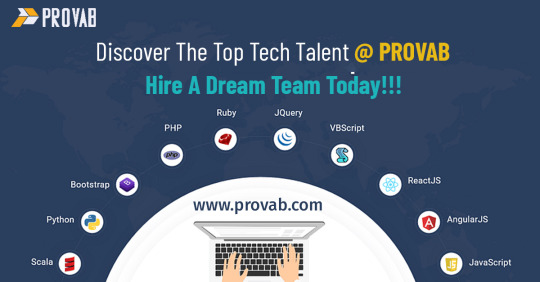
Are you willing to hire java developers onsite or remote? Connect and find the best java expert programmers to develop a prototype or an enterprise grade java application for rapid deployment at 50% lower cost. Our java developer’s are available hourly or full time on T & M - time and material model. If you are looking to hire a java developer or to set up a dev team of java experts including PM, senior developers and full-stack developers - LETS TALK!!!
>>Hire Java Developers - https://www.provab.com/hire-java-developers.html
Provab Technosoft offers best software solutions by deploying dedicated java developers with high expertise. These developers also possess strong proficiency in multiple industry verticals and can respond to functional know-how of these industries. Our dedicated java programmers work as an integral part of customer’s product development team and work as full-time staff or ad-hoc basis as per the need.
Developers in Bench - https://www.provab.com/hire-bench-developers.html
Provab has a team of 300+ professionals and its dedicated java application development team follows the agile methodology to bring the customer idea into reality by deploying web portals, enterprise web applications, intranet systems and custom applications.
PROVAB’s Java Development Services

java developers at PROVAB hold extensive experience in everything from back-end to front-end database and thus deliver best in class solutions to the clients. Our professional full stack programmers are well-versed in java to MEAN Stack, Node.js, Angular.JS, Ruby on Rails, ReactJS, Laravel and others. Our experts have unrivaled experience in the full stack software development field.
Java Application Development
Custom java application development gives you a greater control over code and implementation. Hire java developers @ PROVAB to set your team.
eCommerce Development
Trust our experienced full-stack programmers with java based e-commerce development to build and deploy high performance online storefronts for any business.
Application Enhancement
Our java application enhancement services include addition of features in legacy applications and upgrade, we use java spring board, hibernate .
Enterprise App Development
Outsource your enterprise app development from ideation to delivery. Hire java developers offshore and get your product done under work for hire agreement.
Product Development in java
Outsource your product development from ideation to delivery. Hire java developers offshore and get your product done under work for hire agreement.
API Integration in Java
Integrate SOAP, JSON or REST API in a web application or app. Hire API developers, coders and consultants proficient in writing best algorithms for performance.
Advantage of hiring remote Java developers
Lets you hire professionals worldwide at right cost
Hassle-free access to Indian workforce
Time utilization
Cost-saving through optimization resources
Higher retention rates with short, mid-term and long term assignments
There are certain clear advantages of hiring top web & mobile developers in India, which is now a hub of all leading IT / software companies.
Setup A Web & App Team in India - https://www.provab.com/hire-dedicated-developers.html
Process of Hiring Remote Java Developers With Us.
Facts to be considered to keep a detailed track of your remote java developers in India:
Take Interview: A remote developer is a judge based on how efficiently and timely communication and tasks are handled.
Sign Legal Agreements: Agreement such as NDA (Non-Disclosure Agreement) and other needful as per the client requirements.
Rapid Communication Tools: Remote developers should know how to handle communication software and also project management tools to help clients to see their progress with screen sharing, add tickets, keep track of work, etc.
Define Task for Developer: Assign a project manager to take a regular look at the project, provide reports and updated regularly.
Work Tracking Software: The software would provide a complete detailed report of the working hours, coding, and time is taken. This will both parties to have an idea on the on-going development
#java developers#java developers in india#java developers in USA#contract basis java developers#remote java developers
0 notes
Text
How to Choose the Right Outsourcing SaaS Development Company in India

Outsourcing SaaS development to India is incredibly appealing due to the abundance of tech talent and cost-effective setting. It's no surprise that numerous businesses are opting for this approach. Nevertheless, the market is saturated, making it challenging to select the perfect partner. Let's navigate through these intricacies together.
The Rising Stakes in SaaS Development Outsourcing
The software-as-a-service (SaaS) market is booming, and the competition is fierce. To stay ahead, businesses are increasingly turning to outsourcing to accelerate development, reduce costs, and tap into specialized expertise. India has emerged as a leading outsourcing hub, but finding the right partner amidst a sea of options can be challenging.
A recent NASSCOM report highlights a significant increase in the number of SaaS startups and enterprises opting for India as their development partner. However, the same report also indicates a rise in cases of project delays, budget overruns, and quality concerns due to poor partner selection.
Why Partnering Matters
A strong development partner can be a game-changer. They bring expertise, speed, and scalability to the table. But choosing the wrong one can lead to project delays, budget overruns, and even product failure.
Accelerated Time-to-Market: A skilled partner can help you launch your product faster, giving you a competitive edge.
Access to Talent: Tap into a pool of skilled developers who might be hard to find in-house.
Cost Efficiency: Outsourcing can often lead to significant cost savings without compromising quality.
Focus on Core Competencies: Let your partner handle the tech while you concentrate on your business strategy.
Why Outsourcing SaaS Development Matters
Outsourcing SaaS development isn't just about saving a buck (though that's nice). It's about gaining access to top talent, scaling your team quickly, and focusing on what you do best - growing your business. India has become a hotbed for tech talent, but with so many options, choosing the right one is crucial.
Imagine this: You've got a brilliant idea for a SaaS product. You've sketched out the features, and you're ready to conquer the world. But then reality hits – building a tech team from scratch is a nightmare. Hiring, training, and managing a team can be a huge distraction. That's where outsourcing comes in.
Decoding the Perfect Partner
So, how do you find a needle in this haystack? Let's break down the process:
Define Your Vision Clearly:
Know Your Product: Clearly articulate your SaaS product's purpose, target audience, and core functionalities.
Set Realistic Goals: Define your project scope, timeline, and budget expectations.
Identify Must-Have Features: Prioritize essential features to guide the development process.
Technical Proficiency is Key
Skill Set Match: Ensure the partner has expertise in your preferred technology stack (e.g., Python, Ruby on Rails, React, AWS).
Proven Track Record: Look for a portfolio of successful SaaS projects, especially in your industry.
Agile Methodology: Prioritize partners who embrace Agile development for flexibility and adaptability.
The Power of People
Communication Channels: Effective communication is vital. Choose a partner who is responsive and uses collaboration tools efficiently.
Cultural Alignment: Shared values and work ethics can significantly impact project success.
Team Stability: High turnover rates can disrupt project continuity.
Security and Compliance
Data Protection: Prioritize partners with robust security measures to safeguard your sensitive information.
Compliance Adherence: Ensure they comply with relevant industry regulations like GDPR, HIPAA, or PCI DSS.
Cost and Value
Transparent Pricing: Avoid hidden costs. Opt for partners with clear pricing models.
Value Proposition: Look beyond the price tag. Consider the overall value offered, including expertise, experience, and support.
Long-Term Partnership
Post-Launch Support: A reliable partner offers ongoing maintenance, updates, and support.
Scalability: Your partner should be able to accommodate your product's growth and evolution.
Facile Technolab: Your SaaS Partner
At Facile Technolab, we've been building successful SaaS products for over two decades. We understand the challenges you face, and we're here to help. Our team of experts combines technical proficiency with a deep understanding of business needs.
We've been in the SaaS development game for over two decades. We've seen the trends, faced the challenges, and emerged stronger. Our team of experts understands the ins and outs of building successful Saas software development companies.
We don't just write code; we build partnerships. Our focus is on understanding your business, your goals, and your customers. We're not just developers; we're your product partners.
We offer a comprehensive range of services, including:
Product strategy and roadmap development
Custom product development
Cloud migration and optimization
Ready to turn your SaaS vision into reality? Let's chat!
Related Resources
Top 5 mistakes when hiring SaaS Development Team and How to avoid them
Related Services
SaaS Development
Related Case Studies
FinTech Modernization and SaaS Development Case Study
Manufacturing Execution System - SaaS Platform Development Case Study
Parking Management SaaS Platform Case Study
Job Management System SaaS Platform MVP for precision component manufacturing company in Australia
More Articles related to SaaS:
Why .NET Core is a popular choice for SaaS Development?
How to Build a 10x More Efficient B2B SaaS Platform in 2024
The Future of B2B SaaS Platform Development: 9 Emerging Trends to Watch in 2024
Creating Your First B2B SaaS Platform MVP: A Comprehensive Tutorial
Building Cloud-Native B2B SaaS Software Solutions: Advantages and Strategies
The 3 Hidden Obstacles Holding Back Your B2B SaaS Dream
The Cost-Effectiveness Myth: Ensuring Value Beyond Cost Savings in Offshore Software Development
Finding Your Perfect Fit: How to Choose the Right SaaS Development Partner in India
How Much Does a B2B SaaS Software MVP Development Really Cost?
0 notes
Text
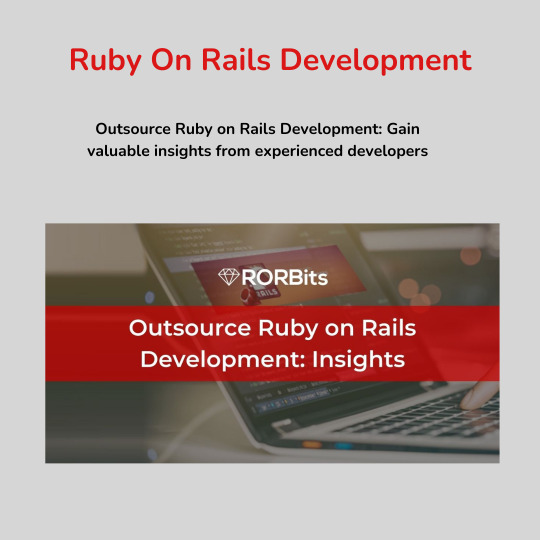
Outsource Ruby on Rails Development: Insights
Outsource Ruby on Rails Development: Gain valuable insights from experienced developers. Boost your project with our expertise.
#ruby on rails development#ruby on rails development company#ruby on rails company#ruby on rails development india#ruby on rails development company india#rails company
1 note
·
View note
Text
Imagine your dream come true with trusted website development company
Website Development Company is famous for consistently developing and preserving websites and for lending a hand in web improvement. We thrive on customers’ pleasure from nearby entities to large organizations. Incorporating our talents with components of innovation and our difficult paintings we goal to exceed all our clients' expectancies, meanwhile, we create web sites that include an appropriate stability of innovation and personnel.

Countless services are to be had from website development company, and right here are a few examples
• Website Design: Create a visually appealing and consumer-friendly web site design and layout that reflects their customer’s emblem and desires.
• Front-end improvement: This involves writing in languages including HTML, CSS, and JavaScript the visual elements of an internet site that users engage with which includes navigation menus, buttons, bureaucracy, and content layouts.
• Back-end improvement: Web applications such as database, server configuration, and alertness good judgment are evolved using programming languages and frameworks inclusive of PHP, Python, Ruby on Rails, and Node.Js.
• E-trade improvement: Some net improvement corporations focus on developing products which includes labels, shopping carts, checkout doorways, and online shops.
• Content Management System (CMS): Build custom CMS structures or paintings with existing ones like WordPress, Drupal, or Joomla to empower customers to effortlessly control and update their website content material.
• Search Engine Optimization (SEO): Websites are optimized for engines like google to rank higher on search engine outcomes pages to improve visibility, boom natural site visitors, and improve on-line performance.
• "Personalized answers: These groups can cater directly to the precise needs of every customer. From a primary informative website to a dynamic on line shop, their customizable alternatives will flawlessly align with the customer's imaginative and prescient and targets."
• Time and price: By outsourcing website development company, customers can keep time and money as compared to hiring a team or attempting to build a website yourself. Web development companies have already got the assets, gear, and approaches needed to be successful within the agreed-upon time and finances
• Maintenance and assist: Web development corporations generally offer ongoing renovation and help offerings to ensure that web sites are steady, up-to-date, and performing nicely over time.
• Access to the cutting-edge era: The practice of web layout is better via the proactive traits monitoring via Website Development Company, leaving them lying in a place updated with technology and for that reason with the cutting-edge equipment and techniques for making present day, practical, and interactive sites.
In end, website development is likewise key to efficiently communicating with the audience in nowadays digital environment whether it's miles a simple informational internet site or e-commerce by building a robust platform, and main internet site development organizations so as to collaborate to offer expertise, excellent answers, fee efficiencies And with the ultra-modern era, companies can increase their logo visibility, for visitors increasing traffic, increasing conversion, and in the long run attaining their on line goals of consider and success round.
Visit For More: digitalspike.co
0 notes
Text
#rubyonrails#html#css#javascript#java#programming#python#webdevelopment#php#webdeveloper#nodejs#laravel#android#vuejs#angular#mysql#jquery#js#software#mongodb#webdesigner#reactjs#nosql#webdesign#coding#machinelearning#developer#stackoverflow#artificialintelligence#softwaredeveloper
1 note
·
View note
Text
Top 7 Tips for Reducing Software Development Costs
Software development costs can easily add up, but with the right strategies in place, you can maximize your budget. In this blog post, we will explore top seven tips for reducing software development costs, helping you save money while still achieving your project goals.
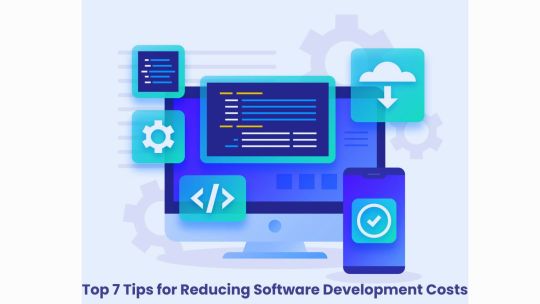
7 Tips for Reducing Software Development Costs
1. Define Clear Objectives and Requirements:
Before diving into the development process, it's crucial to have a clear understanding of your project's objectives and requirements. Ambiguities and frequent changes in specifications can lead to increased development time and costs. Collaborate closely with your development team to create a detailed project plan that outlines the scope, features, and expected outcomes. This upfront investment in planning pays off in the long run by preventing costly alterations during the development phase.
2. Embrace Agile Development Methodology:
Agile development methodologies, such as Scrum or Kanban, offer a flexible and iterative approach to software development. By breaking down the project into smaller, manageable sprints, you can continuously evaluate progress and make adjustments as needed. This iterative process not only accelerates development but also allows for more accurate budgeting, reducing the risk of unforeseen expenses.
3. Open Source Technologies and Frameworks:
Consider leveraging open source technologies and frameworks to reduce licensing costs and development time. Open source software often comes with a supportive community and regular updates, ensuring a reliable foundation for your project. Popular frameworks like Django, Ruby on Rails, or Laravel can streamline development, providing a cost-effective solution without compromising on quality.
4. Outsource Wisely:
Outsourcing development tasks to countries with lower labor costs can be a game-changer for budget-conscious business owners. However, it's crucial to choose a reliable outsourcing partner with a proven track record. Conduct thorough research, check references, and establish clear communication channels to ensure a smooth collaboration. Outsourcing can significantly reduce development costs while providing access to a diverse pool of skilled professionals.
5. Prioritize MVP Development:
Consider adopting a Minimum Viable Product (MVP) approach to launch your software with essential features first. This allows you to enter the market faster, gather user feedback, and make informed decisions about future enhancements. By prioritizing core functionalities, you can minimize initial development costs and allocate resources more efficiently based on user input.
6. Automated Testing for Quality Assurance:
Investing in automated testing tools can save both time and money in the long run. Automated tests ensure that your software functions correctly and helps identify and fix bugs early in the development process. By reducing the need for extensive manual testing, you can streamline the development cycle and allocate resources more effectively.
7. Continuous Monitoring and Optimization:
Once your software is live, continuous monitoring and optimization become critical. Use analytics tools to track user behavior, identify performance bottlenecks, and gather insights for future enhancements. Proactively addressing issues and optimizing the software's performance can prevent costly downtimes and ensure a positive user experience.
Conclusion
Implementing strategies to reduce software development costs is crucial for businesses aiming to maximize efficiency and profitability. By focusing on clear project planning, efficient resource allocation, and the use of cost-effective tools and technologies, companies can successfully manage their expenses without compromising on quality. Embracing these cost-saving tips will not only streamline the development process but also contribute to the overall success of the project.
Ready to slash your software development costs without compromising quality? Get in touch with us at [email protected] and let's strategize your budget-efficient project together!
#software#softwaredevelopment#softwaredevelopmentcost#reducesoftwaredevelopmentcost#howtoreducesoftwaredevelopmentcost#iihglobal#softwaredevelopmentcompany
0 notes